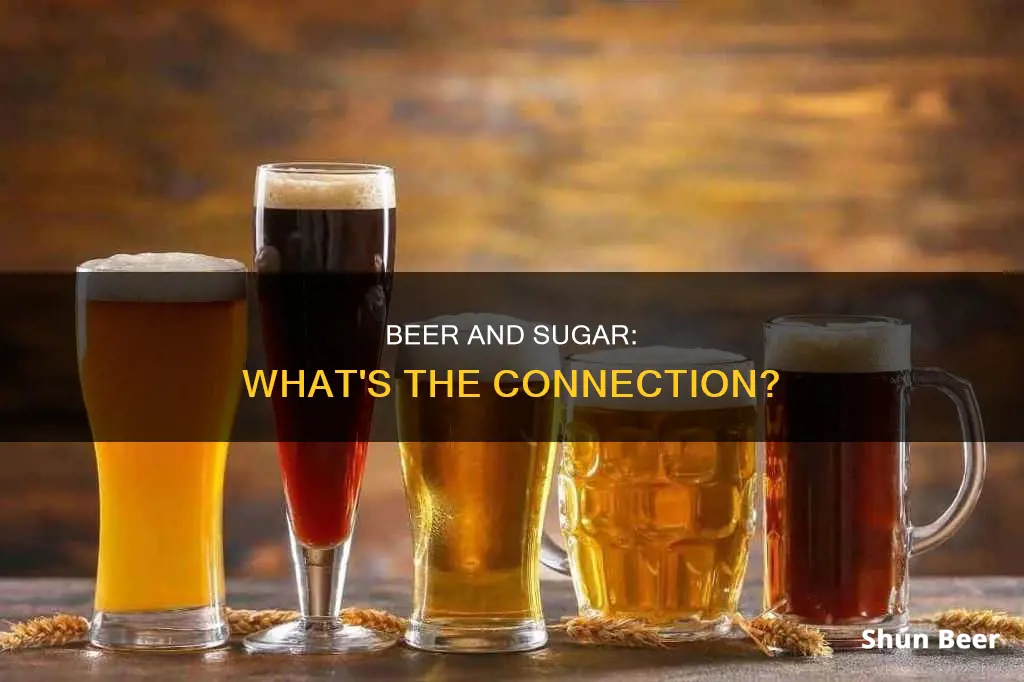
Beer is a popular alcoholic beverage made from yeast, grains, spices, and water. While sugar is not added to the ingredient list, it is naturally created when the grains are processed and fermented by yeast. The amount of sugar in beer depends on several factors, including its gravity, the type of yeast used, and any additional flavours included, such as honey or corn syrup. Beer typically contains little sugar, and its sugar content is generally very low. However, it contains carbohydrates, which the body can turn into sugar, so it should be consumed in moderation.
What You'll Learn
- Beer is made from yeast, grains, spices, and water
- Sugar is created when grains are processed and fermented by yeast
- Beer gravity refers to the density of the liquid extracted from the mashing process
- Beer contains varying amounts of sugar depending on its style and brewing method
- Beer is an alcoholic drink that can lower blood sugar levels

Beer is made from yeast, grains, spices, and water
Beer is made from four primary ingredients: yeast, grains, hops, and water. The specific combination and preparation of these ingredients determine the character and flavour of the beer.
Yeast
Yeast is a type of fungus that metabolises the sugars extracted from grains, producing alcohol (ethanol) and carbon dioxide as by-products. The type of yeast used, such as ale or lager yeast, influences the character and flavour of the beer. Ale yeast tends to have a higher alcohol tolerance than lager yeast, resulting in ales with higher alcohol and lower sugar content.
Grains
Grains, such as barley, wheat, rice, corn, oats, and rye, provide the fermentable material for the yeast to feed on. The grains undergo a malting process, where they are soaked in water, germinated, and then dried. This process breaks down complex carbohydrates into simple sugars, like glucose and maltose, that can be easily fermented by the yeast. The specific grains used and the malting process contribute to the colour, flavour, and aroma of the beer.
Hops
Hops are the flowers of a perennial vine and are added for bitterness, flavour, and aroma. They provide a piquant aroma, a variety of flavours, and a delicate to intense bitterness that balances the sweetness of the malt. Hops also have preservative properties, aiding in the stability and longevity of the beer.
Water
Water is the main ingredient in beer, accounting for about 93% of its weight. The quality and mineral content of the water can significantly impact the taste of the beer. Different regions have distinct water profiles, which have historically influenced the development of specific beer styles. For example, Dublin's hard water is well-suited for brewing stouts, while the Plzeň Region's soft water is ideal for brewing Pilsner.
Dark Beer's Sweet Secret: More Sugar, More Flavor?
You may want to see also

Sugar is created when grains are processed and fermented by yeast
Beer is created through a natural process that involves four main ingredients: barley, water, hops, and yeast. The process begins with the malting stage, where barley grains are soaked in water, germinated, and dried. This malting process helps break down complex carbohydrates into simple sugars like glucose, which are more easily fermentable by yeast.
The malted barley is then mixed with hot water to create a thick, oatmeal-like substance called mash. The sugary liquid is extracted from the mash and is known as wort. The wort is then boiled, and hops are added to impart bitterness and balance out the sugar. The boiling process also helps stabilize the wort.
After boiling, the wort is cooled and yeast is added to begin the fermentation process. Fermentation is where sugar is converted into alcohol and carbon dioxide through the action of yeast enzymes. This process can be broken down into two parts: primary fermentation and secondary fermentation. During primary fermentation, the yeast converts sugars into alcohol and carbon dioxide. Secondary fermentation allows the beer's flavours to develop further, adding complexity and improving the taste.
The fermentation process can take varying amounts of time, depending on the type of beer being made. Ales, for example, may ferment for a matter of days, while lagers may ferment for several weeks.
Overall, the creation of sugar during beer-making occurs during the malting and mashing stages, where the grains are processed to break down their starches into simple sugars. These sugars are then fermented by the yeast, converting them into alcohol and carbon dioxide, which gives beer its alcoholic content and carbonation.
Abita Beer: Sugar Content and Nutritional Facts
You may want to see also

Beer gravity refers to the density of the liquid extracted from the mashing process
Beer gravity, also known as specific gravity, is a fundamental concept in brewing that refers to the density of the liquid extracted from the mashing process. This liquid, known as wort, is a crucial intermediate product in beer production, as it contains the sugars that will be converted into alcohol during fermentation.
The density of wort is measured relative to water, with water serving as the reference point with a density of 1.000. The specific gravity of wort provides a relative measure of its density compared to water, indicating the presence of dissolved substances, primarily sugars derived from malted grains. A specific gravity reading higher than 1.000 indicates the presence of dissolved substances, as they are denser than water.
Original gravity (OG) is measured before fermentation and indicates the concentration of sugars in the wort. A higher original gravity signifies a greater concentration of sugars, which can lead to a higher alcohol content if the yeast ferments these sugars completely. As yeast ferments the sugars, the gravity decreases because the sugars are converted into less dense alcohol and carbon dioxide.
Final gravity (FG) is measured at the end of fermentation and indicates the residual sugar content, giving an idea of the beer's sweetness, body, and alcohol content. The difference between the original gravity and final gravity can be used to calculate the alcohol by volume (ABV) of the beer.
Understanding and controlling beer gravity is essential for brewers as it influences not only the alcohol content but also the flavour, body, and mouthfeel of the beer. Beers with higher original gravity tend to result in richer, fuller-bodied beers, while those with lower original gravity are typically lighter and more refreshing.
In addition to specific gravity, there are other scales used to measure gravity, including Balling, Brix, and Plato. These scales provide slightly different perspectives on the sugar concentration in wort and are chosen based on the specific needs and characteristics of the brewing process.
Overall, beer gravity is a critical parameter in the brewing process, providing valuable information about the potential alcohol content, flavour development, and consistency of the final beer product.
Beer and Blood Sugar: What's the Connection?
You may want to see also

Beer contains varying amounts of sugar depending on its style and brewing method
Beer contains varying amounts of sugar, depending on its style, ingredients, and brewing method. The sugar content in beer is influenced by several factors, including the type of yeast, brewing process, and additional flavourings used.
Firstly, let's understand how beer is made and where sugar comes into the equation. Beer is typically made from yeast, grains, spices, and water. The grains, usually barley and wheat, undergo a process called malting, where they are soaked, germinated, and dried. This malting process breaks down complex carbohydrates into simple sugars like glucose, which are more easily fermented by yeast. The grains are then roasted, milled, and soaked in hot water, resulting in a sugar-containing liquid called wort. During the boiling step, hops or other spices are added, and the wort is then cooled and filtered.
At this point, yeast is introduced to the wort to begin the fermentation process, where sugars are converted into alcohol and carbon dioxide. The yeast ferments the simple sugars, while some residual complex sugars remain, contributing to the final sugar content of the beer. The type of yeast and the efficiency of fermentation can impact the amount of sugar left in the beer.
Additionally, beer gravity, which refers to the density of the wort, plays a significant role in determining the sugar content. A wort with a high sugar concentration is called a high gravity wort, and it will produce a beer with higher sugar levels post-fermentation. On the other hand, low-gravity beers typically have lower sugar and alcohol content.
The addition of flavourings and ingredients can also affect the sugar content of beer. Some brewers add honey, corn syrup, or extra sugar to enhance the flavour or increase the alcohol content. These additions will result in a higher sugar content in the final product.
The style of beer also influences its sugar levels. For example, lagers and pilsners tend to have lower sugar content, while heavier, malty beers like stouts and real ales tend to have higher carbohydrate content, which can impact blood sugar levels.
Light beers, on the other hand, generally have slightly higher sugar content than regular beers due to differences in their fermentation process. Non-alcoholic beers have the highest sugar content as none of the sugar is converted into alcohol.
In summary, the sugar content in beer varies depending on multiple factors, including the brewing process, ingredients, yeast, and beer style. While beer does contain sugar, the amounts are generally low, and it is mostly comprised of fermentable sugars and oligosaccharides, a type of carbohydrate. However, it's important to note that beer contains carbohydrates, which can affect blood sugar levels, especially for individuals with diabetes or blood sugar concerns.
Beer vs Jack: Which Drink Has More Sugar?
You may want to see also

Beer is an alcoholic drink that can lower blood sugar levels
Beer is a popular alcoholic drink, and many people are curious about its sugar content. The sugar in beer is created during the fermentation process, where yeast converts sugars from malted grains into alcohol. While beer does contain sugar, the amount varies depending on the type and brand. Generally, beer has less sugar than other alcoholic drinks, but some beers have higher sugar content due to added ingredients like honey or corn syrup.
Beer gravity, or the density of the wort (liquid extracted during brewing), plays a crucial role in determining the sugar content of beer. A wort with a high sugar concentration is called a high gravity wort. During fermentation, the yeast decreases the sugar content while increasing the alcohol content, resulting in a lower gravity beer with a higher alcohol percentage.
The sugar content in beer is typically comprised of 80% fermentable sugars and 20% oligosaccharides, a type of carbohydrate. Oligosaccharides are not digestible by the human body and are considered calorie-free. Therefore, despite containing carbohydrates, beer's sugar content is relatively low.
Regular beers tend to be sugar-free, while light beers typically contain less than 1 gram of sugar per can. Interestingly, non-alcoholic beers have the highest sugar content among beer types because none of the sugar is converted into alcohol. However, it's important to note that labeling regulations for alcoholic beverages in the United States do not require manufacturers to disclose sugar content, making it challenging to determine the exact amount of sugar in a beer.
While beer may not have a significant amount of sugar, it is essential to understand its impact on blood sugar levels. Alcohol impairs sugar metabolism by inhibiting the body's ability to produce and break down stored sugar, leading to potential hypoglycemia or low blood sugar levels. Therefore, it is generally recommended to consume alcohol with a meal containing carbohydrates to compensate for the expected drop in blood sugar.
Additionally, alcohol can have varying effects on different individuals, so testing blood glucose levels before, during, and after drinking is advisable to understand how it personally affects you. Beer, as an alcoholic drink, can lower blood sugar levels, and consistent consumption of high-sugar and high-carb beverages like beer may lead to long-term fluctuations in blood sugar levels, increasing the risk of developing type 2 diabetes or other blood sugar-related issues.
Beer's Sodium and Sugar Content: What You Need to Know
You may want to see also
Frequently asked questions
Yes, beer contains sugar. The sugar in beer is created during fermentation, which converts the sugars from malted grains into alcohol.
The amount of sugar in beer varies depending on the type and brand. Generally, beer has less sugar than other alcoholic drinks like wine. However, some beers can have higher sugar content due to added ingredients, such as honey or corn syrup.
It depends on the type of beer and the quantity consumed. Some beers may have a higher sugar content, while others have relatively low sugar levels. If you're trying to maintain balanced blood sugar levels, it's advisable to limit your consumption of beer and other alcoholic drinks.







